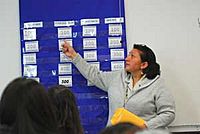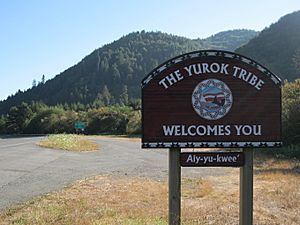Yurok language facts for kids
Quick facts for kids Yurok |
||||
|---|---|---|---|---|
| Pueleekla’ | ||||

Instruction teaching Yurok with the Yurok Language Program
|
||||
| Native to | United States | |||
| Region | Northwestern California | |||
| Ethnicity | Yurok | |||
| Extinct | 26 March 2013, with the death of Archie Thompson | |||
| Language family |
Algic
|
|||
| Writing system | Latin | |||
|
||||
Yurok is a special language from the Algic language family. It was traditionally spoken by the Yurok people. They live in Del Norte County and Humboldt County on the northern coast of California. Most Yurok people now speak English.
The last person who grew up speaking Yurok, named Archie Thompson, passed away in 2013. But don't worry! People are working hard to bring the language back. In 2012, Yurok language classes started in high schools. Many other efforts are helping more people learn to speak Yurok again.
Contents
What's in a Name?
The name "Yurok" comes from the Karuk language. It means 'downriver'. The Yurok people call themselves Puliklah. This name also means 'people of downstream'. So, both names mean the same thing!
A Look at Yurok History
The Yurok language started to decline during the California Gold Rush. Many new settlers came to California, and they brought diseases that harmed the native populations.
Later, Native American boarding schools also caused the language to decline faster. The U.S. government created these schools to make Native American children fit into mainstream American society. This often meant they were not allowed to speak their native languages.
Bringing the Language Back to Life
The effort to revive Yurok is considered one of the most successful language comeback programs in California.
As of 2014, six schools in Northern California teach Yurok. Four are high schools, and two are elementary schools. Rick Jordan, a principal at Eureka High School, shared how important schools are. He said that a long time ago, schools tried to stop the language. Now, they are helping to bring it back.
The last person who spoke Yurok as their first language, Archie Thompson, died on March 26, 2013. He was one of about 20 elders who helped save the language. Experts in the 1990s thought Yurok would be completely gone by 2010. But Archie Thompson and others worked hard to prevent that. He made recordings of the language. These recordings are now kept by linguists at UC Berkeley and the Yurok tribe. He also spent many hours teaching Yurok in schools and communities.
In 2001, linguists at UC Berkeley started the Yurok Language Project. Professor Andrew Garrett and Dr. Juliette Blevins worked with tribal elders to create a Yurok dictionary. This dictionary is now a great example for other language projects. The Yurok Language Project offers more than just a printed dictionary. It's available online and you can search it easily. There's also an audio dictionary where you can hear how words and phrases sound. For deeper study, there's a database of texts where you can see words and phrases used in sentences.
By February 2013, over 300 people could speak basic Yurok. About 60 people had intermediate skills, and 37 were advanced. Seventeen people were able to have full conversations in Yurok. By 2014, nine people were certified to teach Yurok in schools. This was possible because of a law passed in California in 2009. This law allows Native American tribes to choose their own language teachers.
How Yurok Sounds
The Yurok language has its own unique sounds. It has different vowel sounds and many consonant sounds. Some of these consonant sounds are not found in English.
For example, Yurok has sounds like 'p (a 'p' sound with a little pop) or 'ch (a 'ch' sound with a pop). It also has sounds made with the back of your tongue, like 'k' and 'kw'.
In Yurok, every word part (called a syllable) starts with a consonant and has at least one vowel.
How Yurok Words Change
Yurok words can change their form in different ways. This is called morphology. Words can have parts added to the beginning (prefixes) or inside (infixes). They can also change their vowels or repeat parts of words.
Repeating parts of words is called reduplication. It often happens at the beginning of a word. This can show that something is happening many times or that there are many of something.
- For example, kelomen means "to turn." If you say kekelomen, it means "to turn several things."
- mɻkʷɻɬ means "peak." If you say mɻkʷɻmɻkʷɻɬ, it means "series of peaks."
Building Yurok Sentences
The most common way to build a sentence in Yurok is to have a noun (a person, place, or thing) followed by a verb (an action word).
- For example, nek helomey-ek means "I am dancing."
- pu:k roʔop' means "The deer is running."
Sentences can also describe what something is. They can have two nouns or groups of nouns.
- For example, wok ne-let means "That is my sister."
Sometimes, a sentence can be just a verb or a group of verbs.
- For example, tmo:l-ok' means "I am shooting."
- hoʔop'-es means "Build a fire!"
Yurok sentences can also be just a noun or a group of nouns.
- For example, kwesi twegoh means "And it was the raccoon."
The order of words can help you understand who is doing what in a sentence.
- For example, ku pegək noʔp'eʔn mewiɬ means "The man chased the elk."
But if the word endings make it clear, the word order doesn't have to be super strict.
- For example, nekac new-ohpeʔn ku wencokws means "The woman saw me." (Here, "me" comes before "saw" but the ending on "saw" tells you who saw whom).
Writing Yurok
As of 2020, Yurok is written using the New Yurok Alphabet. This alphabet uses letters from the Latin alphabet, just like English. Before this, Yurok was sometimes written using a different alphabet called Yurok Unifon. However, the Latin alphabet is now preferred because it's easier to write, type, and read.
There is a project happening to make the spelling of Yurok words even simpler. So, some letters might look a little different in older texts compared to how they are taught today.
Some books have been written partly in Yurok. One example is the graphic novel Soldiers Unknown. It was written by Chag Lowry. A Yurok language teacher named James Gensaw translated the Yurok text in the book.
See also
 In Spanish: Idioma yurok para niños
In Spanish: Idioma yurok para niños


